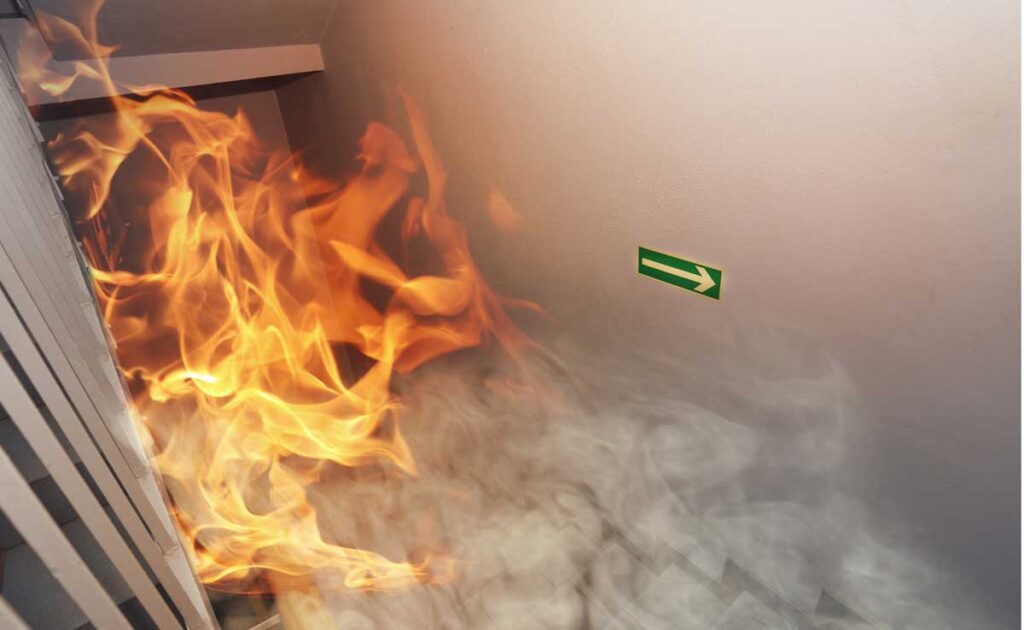Year after year, fire remains an ever-present danger. The most recently available statistics from the National Fire Protection Association (NFPA) show that local fire departments throughout the United States responded to an estimated 1.5 million fires nationwide. In a single year, these fires resulted in:
- 3,790 civilian fire deaths
- 13,250 reported civilian fire injuries
- $18 billion in property damage
More than one-third of these fires, around 35%, were structural fires, including fires at homes, businesses, and government buildings. Because of how prevalent structural fires are, states and municipalities have fire codes in place that dictate requirements for fire prevention technology. ASI Security can install this technology on your property, and monitor it so that you have real time intervention before a hazard becomes a full-blown fire. Here are some of the most popular fire prevention solutions we offer.
Advance Smoke Detection
\”Where there’s smoke, there’s fire\” is a time-honored expression for good reason: It’s true. The NFPA produces consumer literature that explains it in these simple terms: \”If there is a fire in your home, there will be smoke.\” For that reason, the NFPA advises that homeowners install a smoke alarm in each bedroom, one outside each sleeping area, one at least 10 feet from every cooking appliance, and one on each level of the home.
As for businesses and public service buildings, every state fire marshal has outlined requirements for smoke detectors; while you should consult local resources to find out what is required in your area, be certain that you will need smoke detectors onsite.
ASI Security can install monitored smoke detectors that ensure the fire department will be dispatched if smoke is detected onsite. Our systems are designed to resist false alarms, so you can be sure of their reliability.
Early Gas Leak Detection
It’s not often reported, but gas leaks are a rapidly rising cause of fires. NFPA research shows that on average, natural gas ignites 4,200 home fires each year in the United States — and U.S. fire departments respond to an average of 125,000 fires caused by residential natural gas or liquefied petroleum gas leaks annually. NFPA data shows that over the past two decades, gas leak fires have increased dramatically on properties of all types.
This is why, in 2002, the NFPA developed a new standard for installing equipment that provides detection and early warning of gas leaks (NFPA 715, Standard for the Installation of Fuel Gases Detection and Warning Equipment). ASI Security installs such equipment in order to help property owners and building occupants detect natural gas leaks, propane gas leaks, butane gas leaks, and more. When you or your tenants are notified of a gas leak early, the property can be vacated before the environment becomes lethally hazardous. Ask us about incorporating early gas leak detection into your fire prevention system. It can save lives and preserve property.
HVAC Duct Detection
Building managers, homeowners, and other property stakeholders should not underestimate the role that HVAC systems can play in fire danger. The fact is, the same HVAC system you rely on to keep the environment comfortable can also be a prime conduit for smoke to travel through, thus multiplying the lethality of a fire. To minimize this risk, ASI Security can integrate a duct detection system that samples air currents in the HVAC equipment and shuts down any dampers or fans that have harmful smoke or gas detected. Subsequently, the detection system sends an alert to the fire alarm control panel so that the fire department will be dispatched. HVAC duct detection is the comprehensive fire protection every building needs.
Call ASI Security to Learn More
These are the key ways in which ASI Security can offer fire deterrence through powerful hazard detection. To learn more about these fire prevention technologies, call ASI Security now at (757) 989-0718, or contact us online for a free quote. We look forward to providing your fire risk assessment.
- Fire Deterrence Through Hazard Detection - January 16, 2024
- Detection Technology for Environmental Winter Challenges - January 5, 2024
- Why Active Shooter Detection Systems are Needed this Winter - December 4, 2023

